Making a Comeback-1 |
||
Although most of the buildings in the city were destroyed by the bomb, some that were damaged but escaped collapse were repaired and used again. In a variety of ways, such buildings supported the lives of the city's residents. The revival not only of bridges, hospitals, schools, and other public facilities but of financial institutions, department stores, and other such structures was an indispensable part of Hiroshima's recovery.
Here, we will introduce some buildings that were restored to their prewar purposes within a short period after the bombing. | ||
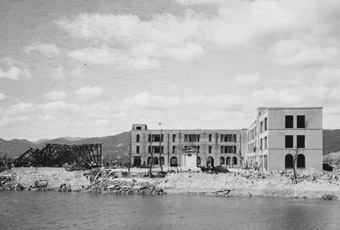 From the east side. The collapsed steel frame to the left of the school building is the wreckage of the auditorium.
From the east side. The collapsed steel frame to the left of the school building is the wreckage of the auditorium. Date of photo is unknown (around fall 1945). Taken by U.S. Army 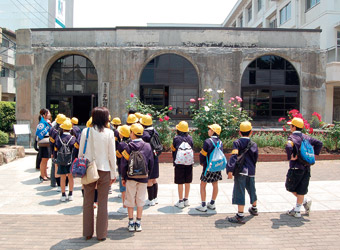 Honkawa Elementary School Peace Museum.
Honkawa Elementary School Peace Museum. May 2008. |
Honkawa Elementary School
In July 1928, a reinforced-concrete three-story school building was constructed at Honkawa Normal Higher Elementary School, the first such building for a public elementary school in the city of Hiroshima. As a result of the bombing, the building was completely burned down except for the outer shell. Approximately four hundred children and more than ten school staff members perished. Two people miraculously survived. From the day after the bombing, the burned-out wreckage was used as a temporary relief station. Although only the outer shell of the school building remained, classes resumed in February 1946, the year after the bombing. In 1988, when the bomb-damaged school building was being dismantled, a portion was preserved and set up as a Peace Museum. 
* Location: 1-5-39 Honkawa-cho, Naka-ku * Distance from hypocenter: 410 meters * Name at time of bombing: Honkawa Elementary School * Structure/number of stories: Reinforced concrete, three stories with partially underground basement floor * Completed: 1928 * Name when completed: Honkawa Normal Higher Elementary School * Current status: Part of bombed building was preserved and is used as Peace Museum. |
|
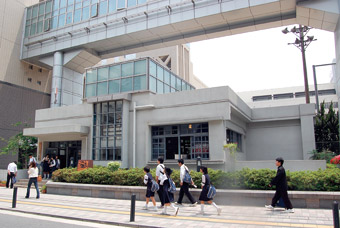 Fukuromachi Elementary School Peace Museum. May 2008.
Fukuromachi Elementary School Peace Museum. May 2008. |
Fukuromachi Elementary School
As a result of the bombing, nearly all of the school staff members and children perished. Only a few survived. The west building, which survived the flames, served as an evacuation site and relief station, as well as a place where people could check on the welfare of the children, school staff members, and people of the community. People used small pieces of chalk that were scattered on the floor to write messages on the burned walls.

* Location: 6-36 Fukuro-machi, Naka-ku * Distance from hypocenter: 460 meters * Name at time of bombing: Fukuromachi Elementary School * Structure/number of stories: Reinforced concrete, three stories with basement floor * Completed: 1937 * Name when completed: Fukuromachi Normal Higher Elementary School * Current status: Part of the A-bombed school building has been preserved and serves as a Peace Museum today. |
|
 Wounded soldiers being cared for in Fukuya, a temporary relief station.
Wounded soldiers being cared for in Fukuya, a temporary relief station. August 9-12, 1945. Taken by Hajime Miyatake / Courtesy of the Asahi Shimbun Company |
Fukuya Department Store
The atomic bomb killed or injured a large number of people who were in the building. Only those with minor injuries managed to escape. Shortly after the bombing, fire completed gutted the interior. With only its outer shell remaining, the building was used for about a month as a temporary infectious-disease hospital for people diagnosed with dysentery but who actually were suffering from the bloody stools characteristic of radiation poisoning.
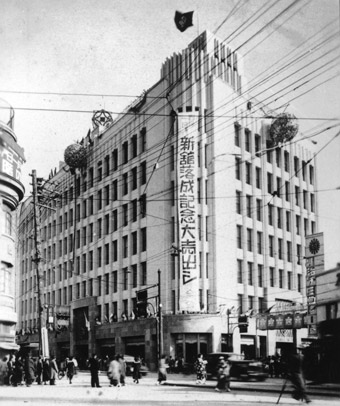 Flamboyant introduction of new wing. 1938.
Flamboyant introduction of new wing. 1938.Courtesy of Fukuya Co., Ltd. 
* Location: 6-26 Ebisu-cho, Naka-ku * Distance from hypocenter: 710 meters * Name at time of bombing: Fukuya Department Store * Structure/number of stories: Steel-framed reinforced concrete, eight stories with two basement floors and two penthouse floors * Completed: 1938 * Name when completed: Fukuya Department Store (New Wing) * Current status: Following repeated remodeling and expansion, continues to serve as part of store. |
|
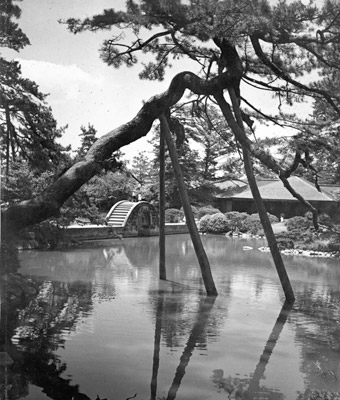 "Kokoukyo Bridge" arching over Takueichi Pond. July 1937. Taken by Kazan Ueda / Courtesy of Takumi Fujinaga  * Location: 2-11 Kami-nobori-cho, Naka-ku * Distance from hypocenter: 1,300 meters * Name at time of bombing: Shukkeien Garden * Current status: Restored to landscape that existed before bombing. |
Shukkeien Garden
In 1620, Nagaakira Asano, lord of the Hiroshima fiefdom, began building Shukkeien Garden as a villa garden. In 1940 the garden was donated to Hiroshima Prefecture by the Asano family, and was designated an official National Place of Scenic Beauty. Local residents came to call it, affectionately, "Sentei." Most of the buildings and trees in the garden were lost to the atomic bomb, but since the garden was a designated air raid refuge, many victims fled to it shortly after the bombing. A great number died here. A clue obtained from a single photograph taken shortly after the bombing led to the excavation of certain areas in the garden. As a result, the remains of 64 people were discovered on August 1, 1987. 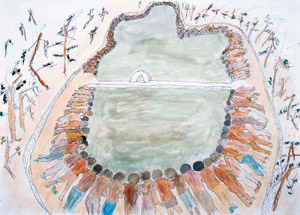 The burnt victims of the A-bomb lined the edge of the pond in Asano-no-Sentei (Shukkeien Garden), pressed together with no space between them, drinking the pond water. The next day, they were all dead, still lined up the same way around the pond. For these people, reaching the edge of that pond was the last thing they ever did. August 6 and 7, 1945 Drawn by Miyoshi Kokubo (Age at bombing-17; at drawing-74) |
|
